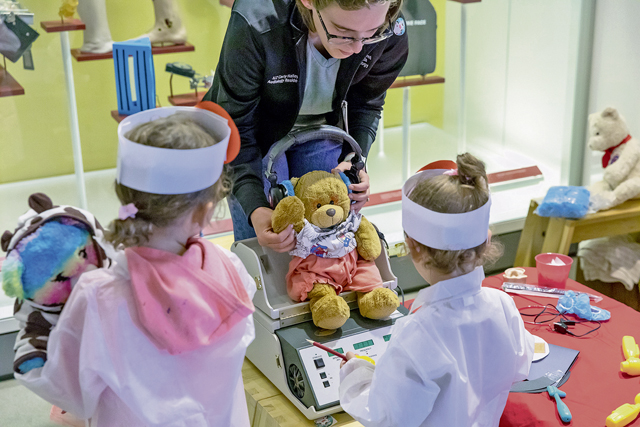
Unfortunate weather didn’t stop the Sep. 23 Teddy Bear Clinic at the National Museum of Health and Medicine. After an absence of the event due to COVID-19, children once again donned lab coats and guided their stuffed animal “patients” to several stations to learn about healthy habits and the body. Stations were led by Walter Reed National Military Medical Center pediatric residents, Uniformed Services University of Health Sciences medical students, and audiologists from the Alexander T. Augusta Military Medical Center and WRNMMC.
After a short welcome into the museum, the young visitors came upon their first station focused on immunizations and vitals. The children were invited to listen to their teddy bears’ hearts, take their blood pressure and temperature, and administer a shot.
“These interactive stations help the children understand the procedures they see and experience when they visit a doctor’s office,” said Public Programs Manager Andrea Schierkolk. “Hopefully the children feel more comfortable in a medical environment after this event.”
They continued their teddy bear doctor appointments at the dental station where, with the help of a giant teeth model, USUHS med students showed them how to properly brush and floss their teeth.
Across from the dental station, children drew their favorite meals on paper plates. A team made up of a WRNMMC pediatric resident, a USUHS med student, and a museum volunteer docent taught the children the importance of a balanced diet, emphasizing everything in moderation.
The nutrition station was not the only one where the children were invited to craft. Guided by WRNMMC pediatric residents, they made reflective headbands and doctor’s kits filled with images of items like bandages, syringes, cotton balls, and more.
By dressing and acting like a doctor, and other medical professionals, with their stuffed friends, the museum hopes to develop early inspiration in considering a field in medicine. One museum visitor said, “My favorite part was seeing doctors tell my girls if you can dream it, they can be it.”
Family fitness was the most active station. USUHS med students showed the children and their bears a variety of stretches that encourage blood flow and can help them avoid injuries.
Hearing was the final station before the children’s teddy bears received a clean bill of health. Showing real equipment children often find intimidating at a doctor’s office, audiologists Dr. Tasha Cantelmo, U.S. Army 1st Lt. Carly Halley, and Dr. Hannah Willison invited the young visitors to test their stuffed friend’s ears to become more relaxed with the process.
“The Teddy Bear Clinic provides a unique opportunity to highlight the role of military pediatrics and military audiology in a friendly setting that allows us to emphasize the historical and current value of military medicine to the nation,” said Schierkolk.
The museum’s public programs provide forums for informal learning that connect the mission of the Department of Defense museum with the public. For more information about upcoming events, call (301) 319-3300 or visit https://www.medicalmuseum.health.mil


